Description
In the industrialised nations, people spend about 90 percent of their lives inside – in apartments, workplaces and vehicles. They spend more than half of this time at the workplace. A good interior climate at the workplace is therefore particularly important for health and well-being. Such a climate is characterised by high thermal comfort and air quality that does not raise any health concerns. At our latitudes, a good interior climate can only be attained at considerable cost and with considerable engineering effort. In the selection of technical designs it is important to ensure that the solution envisaged is both economically viable for the investor and low on resource consumption, with low pollution emission levels.
In order to achieve these goals, integral planning is necessary, particularly for office buildings. It should combine into an optimum total system both thermal protection and energy-efficient climate conditioning technology (heating, air supply, cooling) drawing upon an energy supply that is as sustainable as possible.
Over the last decades, the continued tightening of government regulations regarding energy conservation has significantly improved the thermal protection of our buildings. During the heating periods occupants now benefit from high surface temperatures inside the building envelope, which increases comfort levels to a noticeable extent. This means that the maximum heating loads are reduced, thus permitting the implementation of heating systems with low mean hot water temperatures (under 30° C) even at low external temperatures. Such low hot water temperatures inevitably result in a move away from heating surfaces with a convective effect to those providing radiant heat requiring reduced heating energy. However, the excess water temperature being low in relation to the room temperature, large heating surfaces are necessary for the required exchange of heat energy. For this reason, heat transfer systems integrated in building components of large surface area are being more frequently implemented, for example in concrete floor slabs, that is in ceilings and floors, or even in walls. In order to avoid the desire to open windows, with consequential high heat losses, an additional step would be to process the fresh air supply required for reasons of hygiene (30-50 m³/h per person) with the aid of a high-efficiency heat recovery system incorporated in the air circulation circuit.
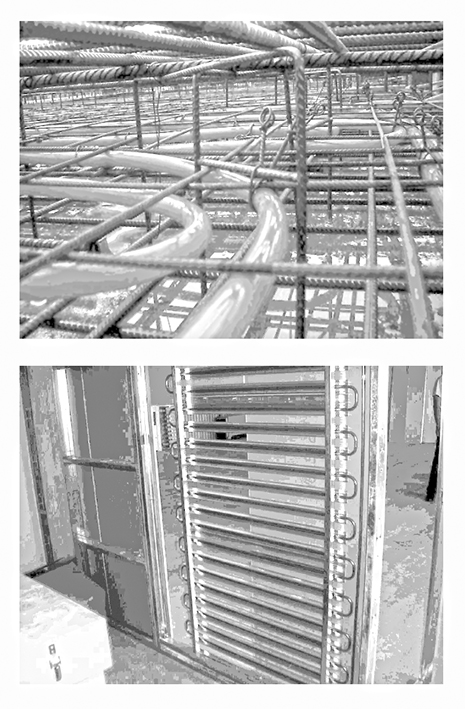
Integrated heat transfer systemabove in the concrete floor, below in the partition walls
However, the beneficial effect on room climate due to increased thermal protection of the building envelope is not the only consideration. This improvement is also partly responsible for the significant increase in the area of glass in many façades, which, due to solar gain, engenders higher levels of room heating with reduced nocturnal cooling of the rooms in summer through the thermos effect. In combination with the internal heat loads generated by computers, people and artificial light, this gives rise to such high total cooling loads that the offices generally require supplementary mechanical cooling. Again, building components with integrated heat transfer systems would seem to be ideal for this, as they are operated (in cooling mode) with more cost-efficient average cool water temperatures of around 20° C, and with correct design, enable comfortable room temperatures to be achieved.
One system of heat energy exchange integrated in building components that has been implemented in office buildings for several years now is the thermal concrete core. Advances in development of this system have produced an extremely interesting concept for room heating and cooling, from both an economic and an ecological perspective.
Plastic pipes are cast into the zone of reinforced concrete floor slab where the concrete is under low stress, that is, between the upper and the lower reinforcing layers, at a spacing of 15 to 30 cm. Water at a mean temperature of approximately 20° C (for cooling) and 26° C (for heating) flows through them, so that the exposed surfaces of the floor slab either emit heat or absorb it, in the case of cooling.
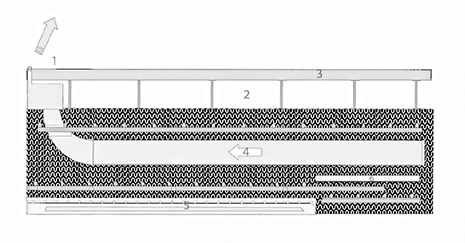
Peripheral strip heating and cooling, developed by DS-Plan in co-operation with the enterprise Zent Frenger1 Air supply outlet2 Reinforcement3 Technical floor4 Air supply5 Peripheral strip heating and cooling6 Thermal concrete core implementation
For cooling, the thermal mass of the building is used to store the heat loads generated during the day. This heat is dissipated at night with the aid of the cool water that flows through the reinforced concrete.
Thermal comfort and the large inertia of the system presuppose a low temperature difference between building component surfaces and the rooms. Because of this, the cooling capability (< 40 W/m²) and in particular, the heating capability (< 30 W/m²) of the system is limited. Usually there is no local temperature regulation; a large number of rooms are subjected to the same heating and cooling effect via water flows through the reinforced concrete floor slabs. In order to redress the balance – sometimes very varied – between the heating or cooling loads, peripheral strip heating and cooling is provided. This enables limited individual regulation of the room temperature. With these systems the room temperature can be individually controlled within a bandwidth of circa 2 to 3° C. Where thermal concrete core implementation is supplemented by this type of room temperature regulation, it excels by delivering good thermal comfort at low environmental impact with low investment and running costs. Because of the low energy requirement for heating and cooling, it lends itself superbly to being fed by regenerative energy sources.
Our environment offers us an abundance of energy, but only a very small proportion of it is available to us in directly usable form, as passive solar energy, for example. More extensive use of the available energy is only possible through investment in technical facilities.
In connection with the use of thermal concrete cores, geothermal energy close to the earth’s surface offers interesting prospects for environmentally friendly climate conditioning. Geothermal energy can be used without interposition of technical facilities in order to cool rooms; for heating, an additional heat pump is required to attain the necessary hot water temperature. Ground water, geothermal bore holes and energy piles may be used as heat sources.
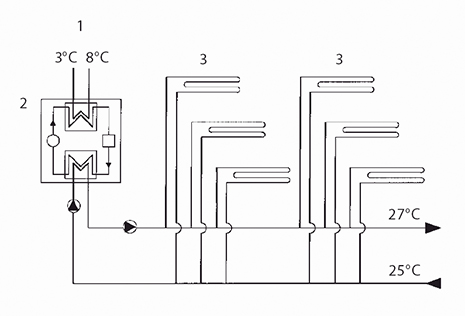
Open cooling1 Geothermal energy2 Heat pump3 Heating pipes of the thermal concrete core implementation
With designs such as this, when high thermal protection of the building is required during heating periods, and with the implementation of electrically driven heat pumps, for example, more than 4 kWh of heat can be generated from one kilowatt hour (kWh) of electricity. With this design, pollution emissions are reduced to the minimum.
Even the heating and cooling energy for processing the air required for reasons of hygiene can be generated with the aid of geothermal energy near the earth’s surface, so that a second heating or cooling system for room ventilation is not necessary.
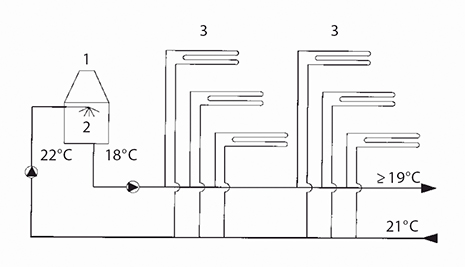
Heat pump supported by the earth’s surface1 Evaporation cooling (during the night)2 Rain water3 Cooling pipes of the thermal concrete core implementation
If adequate cooling cannot be achieved with the aid of ground water or bore holes, an obvious solution is evaporation cooling. At night the heat stored in the reinforced concrete floor slab is conveyed by the circulating water and passed through a heat exchanger element. This element is sprayed with water to cool the circulating water either by heat transfer or evaporation or a combination of both (open cooling). The heat exchanger does not need to be sprayed with drinking water if sufficient rainwater can be collected from the roof’s surface.
Seventy to eighty percent of the necessary cooling energy of an office can be generated with similarly environmentally sustainable concepts.
Wind energy can be employed for ventilation at no cost by using window ventilation. It can be very effectively implemented for the purposes of external air supply and for the cooling of rooms in transitional periods. If the right windows are chosen, and if the outside temperatures are lower than the room temperature, thermal currents alone can generate so many air changes in a room that higher cooling effects can be achieved than with the usual mechanical ventilation.
If offices are supplied with external air via central ventilation facilities, extensive habitable volume is necessary to accommodate items such as air shafts and air ducts. Moreover, suspended ceilings are usually necessary in order to accommodate fresh and waste air ducts. These clearly have a disadvantageous effect on the required storey height. In contrast, the use of de-central-ised ventilation systems avoids these disadvantages. These systems draw in external air through the façade where it is filtered and warmed. To achieve this, air filters, fans and heat exchangers for heating and cooling, as well as heat recovery devices are integrated in the façade or in the structure. The quality of air filtering has been limited until now, so that such systems should only be implemented on sites where the quality of outside air is good. Adjusting the humidity of external air is only possible at great cost.
In addition to the space savings already mentioned, the investment costs for climate conditioning and the energy costs are generally lower than those for a building with an equivalent centralised mechanical ventilation system.
Ventilation integrated in the floor lends itself to implementation with double-skinned façades in particular. The outside air is drawn in through the space between the façades with the aid of an electrically powered fan and blown into the room through a coarse filter via the heating or cooling convector that is cast into the floor slab. Occupants can regulate the fresh air temperature individually to a limited extent. Waste air can be drawn off either centrally or through a neighbouring ventilation module.
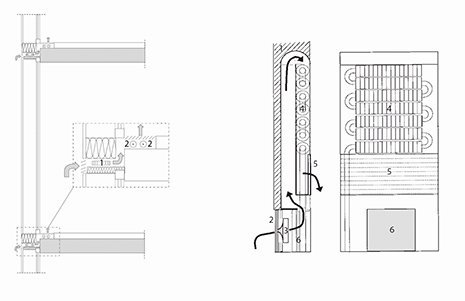
left Ventilation integrated in floorright Decentralised ventilation façade1 Heat insulation2 Damper3 Throttle element4 Heat exchanger for heating and cooling5 Air outlet6 Electrostatic filter
In order to avoid the disadvantage of increased maintenance costs for fans, a de-centralised ventilation façade (development of the enterprise DS plan) without fans and auxiliary electrical propulsion was developed for integration in the façade. The external air is drawn in via a central air supply system. Despite changing pressure differences between outside and inside, the flow of air is kept constant with the aid of a self-regulating throttle element. Were the heating to fail, the heating pipes in the façade would be in danger of freezing, as they are in contact with the outside air. However, inserting an automatic temperature controlled valve into the outer shell can prevent freezing at critical external temperatures.
Originally published in: Rainer Hascher, Simone Jeska, Birgit Klauck, Office Buildings: A Design Manual, Birkhäuser, 2002.